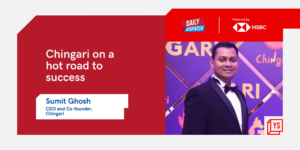The pandemic has catalysed the growth of several new-age D2C brands that are competing head-on with legacy companies, generating unprecedented revenue like never before. Most of these brands stand out for their distinctive USPs, but is there really a secret sauce to their success? That’s the piece of the puzzle aspiring entrepreneurs are looking to discover.
To understand the key factors behind the success of D2C brands, and also their challenges, the Brands of New India (BONI) community, in association with Shiprocket, organised D2C Carwaan in Indore to meet D2C brands and understand their scale. The panel included Anubhav Dubey, Founder, Chai Sutta Bar; Niti Singhal, Founder and Designer, Twee In One; Atul Mehta, COO, Shiprocket; Abhishek Bardia, Executive Head, MP, Startup Centre; and Mohit Jain, Co-founder and CEO, Kimirica Hunter International.
Unravelling the success behind D2C brands
Commenting on the success of Chai Sutta Bar, Anubhav highlighted that everything from their marketing to competitive pricing, and the target group they were looking at, worked for them.
But there are several other factors that govern the success of D2C brands, believes Niti. Timely deliveries are crucial today, and that can’t be neglected in any way, especially in the face of stiff competition.
“You also need to know if you are solving a problem or not, and ensure that you market your product correctly,” she added.
Building customer relations
Customer centricity should be the focus of brands – but this can be segmented into two parts, highlighted Atul. To begin with, the delivery experience brands provide is what determines customer retention.
But there’s another critical factor to keep in mind. “We have to remember that every customer is unique, so how am I segmenting my existing customer? Data segmentation is an opportunity when it comes to customer relations,” he explained.
Similarly, Abhishek is of the view that frequent interaction with customers is what helps the quick growth of any brand.
“The more you interact with your customers, the more your product will be refined – this means you can make it more market-friendly and acceptable. Most startups are shy out to customers, but you shouldn’t make that mistake,” he added.
Adopting a ‘local’ strategy
Recounting his early days, Mohit shared how when their brand started out in 2012, there was a huge gap in the hospitality market in India – 90 percent of the toiletries were imported from China. Today, the gap has been bridged.
Along with Kimirica’s growth, the brand also introduced a programme called ‘Procure within 100’ that laid down guidelines that there should be 50 percent or more procurement, within 100 kilometre radius of the Kimirica plant in Indore.
“We partnered with about 30 small factories and 60-70 percent of our supplies came from neighbouring areas – roughly 20 kms from the Kimirica plant. We have done our best to support local entrepreneurs,” shared Mohit.
Government as an enabler
Although the government has a limited role to play in the success of any brand, Abhishek believes that it can play the role of an enabler. For instance, when a brand has to establish a manufacturing facility, favourable policies of the government can help them take that step. He applauded Madhya Pradesh’s manufacturing policies, calling it one of the most favourable for entrepreneurs in the country.
“You need to have the right market to test your product, which can be scaled up. Indore and MP as a whole are big on diversity, so testing here is a good idea. Indore is also favourable from a logistics perspective,” he explained.
The last word
While there are several other factors that can make or break the journey of a D2C brand, Atul believes that it is critical to leverage technology, to provide top-notch service to customers.
It is also significant to analyse the differentiator, so that the brand can stand out amongst the clutter today.
“You need to analyse your strongest P out of the four Ps – product, place of selling, pricing, or promotion. Another P that keeps you going is passion; the hunger for growth,” he concluded.










